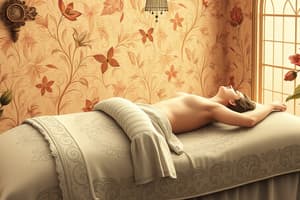Podcast
Questions and Answers
Which of these factors control the results of massage strokes? (Select all that apply)
Which of these factors control the results of massage strokes? (Select all that apply)
- Height
- Speed (correct)
- Intention (correct)
- Rhythm (correct)
The factor that affects the outcome of a technique or massage is the ___________ with which it is given.
The factor that affects the outcome of a technique or massage is the ___________ with which it is given.
therapeutic intent
Which of the following are external forces that deform the body's tissues positively? (Select all that apply)
Which of the following are external forces that deform the body's tissues positively? (Select all that apply)
- Compressive forces (correct)
- Twisting forces (correct)
- Tensile forces (correct)
- Magnetic forces
Massage strokes are directed toward the heart to affect the flow of _____________ and ___________
Massage strokes are directed toward the heart to affect the flow of _____________ and ___________
What are the seven common massage methods? (Select all that apply)
What are the seven common massage methods? (Select all that apply)
Which of the following massage movements are classified as gliding methods? (Select all that apply)
Which of the following massage movements are classified as gliding methods? (Select all that apply)
Which of the following techniques is primarily used in foot reflexology?
Which of the following techniques is primarily used in foot reflexology?
Massage strokes directed toward the heart are termed centripedal.
Massage strokes directed toward the heart are termed centripedal.
To have a sedating effect, the rhythm of the massage must be steady and slightly faster than the client's natural rhythm.
To have a sedating effect, the rhythm of the massage must be steady and slightly faster than the client's natural rhythm.
Deep massage techniques that cause a client to react in pain must be avoided.
Deep massage techniques that cause a client to react in pain must be avoided.
Which techniques are used to relieve muscle spasms, stress points, and trigger points?
Which techniques are used to relieve muscle spasms, stress points, and trigger points?
What is the primary indication of tension or dysfunction in muscle or soft tissue?
What is the primary indication of tension or dysfunction in muscle or soft tissue?
The technique of lifting and squeezing a part of the body is considered __________.
The technique of lifting and squeezing a part of the body is considered __________.
A technique that causes an increase in the amount of blood in an area or hyperemia is called compression.
A technique that causes an increase in the amount of blood in an area or hyperemia is called compression.
The technique of sliding the hand over some portion of the client's body with varying amounts of pressure is called percussion.
The technique of sliding the hand over some portion of the client's body with varying amounts of pressure is called percussion.
What is used to assist a client in restoring mobility or increasing flexibility in a joint?
What is used to assist a client in restoring mobility or increasing flexibility in a joint?
Flashcards are hidden until you start studying
Study Notes
Massage Movements Overview
- Seven factors influencing massage results: intention, direction, speed, length, duration, pressure, rhythm.
- Key external forces affecting tissue deformation: compressive, tensile, torsion, shearing.
Stroke Direction and Purpose
- Massage strokes directed toward the heart enhance venous blood and lymph circulation.
- Movements directed away from the heart are known as centripetal.
Common Massage Techniques
- Seven primary massage methods: static, gliding, torsion, shearing, oscillating, percussive, joint movement.
- Static methods include: superficial touch, deep touch, holding.
- Gliding methods involve: aura stroking, feather stroking, superficial gliding (effleurage), deep gliding.
- Torsion methods: kneading petrissage, fulling, skin rolling, wringing.
- Shearing methods: superficial friction, deep friction, rolling, chucking, compression.
- Oscillating methods include: shaking, jostling, rocking, vibration.
- Percussive methods consist of: tapping, cupping, slapping, hacking, beating.
Client Conditions and Techniques
- Superficial touch is favored for clients with high blood pressure, nervousness, pain, or critical illness.
- Deep gliding is appropriate for healthy clients with thick musculature or those requiring deeper relaxation.
- Deep touch techniques focus on trigger points in areas like the neck and shoulders.
- Superficial gliding is suitable for clients with insomnia or general fatigue.
Specialty Massage Elements
- Joint movement techniques entail manipulation of joint articulations and may include active, assistive, resistive, or passive movements.
- Kneading involves lifting, squeezing, and pressing tissues in a circular motion.
- Friction techniques manipulate one layer of tissue against another, categorized as deep or circular.
Therapeutic Applications
- The pressure in massage techniques typically begins softly, increases, then tapers off.
- Techniques inducing sedation should occur with a steady rhythm slightly slower than the client's natural rhythm.
- Cross-fiber friction is essential for reducing fibrosis and scar tissue after soft tissue injuries.
- Deep static touch can alleviate spasms, stress points, and trigger points.
General Principles
- Touch serves as a primary communication mode for massage practitioners.
- Understanding the purpose and effects of massage movements informs therapeutic treatments tailored to client needs.
- Proper client communication can enhance the overall efficacy of the massage experience.
- Overall health considerations influence technique application and depth of massage strokes.
Studying That Suits You
Use AI to generate personalized quizzes and flashcards to suit your learning preferences.




